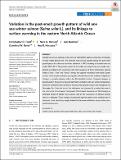Files in this item
Variation in post-smolt growth pattern of wild one sea-winter salmon (Salmo salar L.), and its linkage to surface warming in the eastern North Atlantic Ocean
Item metadata
| dc.contributor.author | Todd, Christopher David | |
| dc.contributor.author | Hanson, Nora N. | |
| dc.contributor.author | Boehme, Lars | |
| dc.contributor.author | Revie, Crawford W. | |
| dc.contributor.author | Marques, Ana R. | |
| dc.date.accessioned | 2020-10-21T11:30:08Z | |
| dc.date.available | 2020-10-21T11:30:08Z | |
| dc.date.issued | 2021-01 | |
| dc.identifier | 270275376 | |
| dc.identifier | e6be0523-1a2f-433b-870d-7df540b4207f | |
| dc.identifier | 85092909438 | |
| dc.identifier | 000579841700001 | |
| dc.identifier.citation | Todd , C D , Hanson , N N , Boehme , L , Revie , C W & Marques , A R 2021 , ' Variation in post-smolt growth pattern of wild one sea-winter salmon ( Salmo salar L.), and its linkage to surface warming in the eastern North Atlantic Ocean ' , Journal of Fish Biology , vol. 98 , no. 1 , pp. 6-16 . https://doi.org/10.1111/jfb.14552 | en |
| dc.identifier.issn | 0022-1112 | |
| dc.identifier.other | ORCID: /0000-0002-9690-2839/work/82500907 | |
| dc.identifier.uri | https://hdl.handle.net/10023/20807 | |
| dc.description | Funding: Canada Excellence Research Chairs, Government of Canada. | en |
| dc.description.abstract | Variation in circulus spacing on scales of wild Atlantic salmon is indicative of changes in body length growth rate. We analyzed scale circulus spacing during the post‐smolt growth period for adult one sea‐winter salmon (n = 1947) returning to Scotland over the period 1993‐2011. Growth pattern of scales was subjectively and visually categorized according to the occurrence and zonal sequence of three inter‐circulus spacing criteria (“Slow”, “Fast” and “Check” zones). We applied hierarchical time‐series cluster analysis to the empirical circulus spacing data, followed by post hoc analysis of significant changes in growth patterns within the identified 20 clusters. Temporal changes in growth pattern frequencies showed significant correlation with sea surface temperature anomalies during the early months of the post‐smolt growth season and throughout the Norwegian Sea. Since the turn of millennium, we observed: (i) a marked decrease in the occurrence of continuous Fast growth, and increased frequencies of fish showing (ii) an extended period of initially Slow growth, and (iii) the occurrence of obvious growth Checks, or hiatuses. These changes in post‐smolt growth pattern were manifest also in decreases in the mean body length attained by the ocean midwinter, as sea surface temperatures have risen. | |
| dc.format.extent | 11 | |
| dc.format.extent | 1283865 | |
| dc.language.iso | eng | |
| dc.relation.ispartof | Journal of Fish Biology | en |
| dc.subject | Cluster analysis | en |
| dc.subject | Growth pattern | en |
| dc.subject | Post-smolt | en |
| dc.subject | Salmo salar | en |
| dc.subject | Scale circulus | en |
| dc.subject | SST anomaly | en |
| dc.subject | QH301 Biology | en |
| dc.subject | SH Aquaculture. Fisheries. Angling | en |
| dc.subject | DAS | en |
| dc.subject.lcc | QH301 | en |
| dc.subject.lcc | SH | en |
| dc.title | Variation in post-smolt growth pattern of wild one sea-winter salmon (Salmo salar L.), and its linkage to surface warming in the eastern North Atlantic Ocean | en |
| dc.type | Journal article | en |
| dc.contributor.institution | University of St Andrews. Sea Mammal Research Unit | en |
| dc.contributor.institution | University of St Andrews. Marine Alliance for Science & Technology Scotland | en |
| dc.contributor.institution | University of St Andrews. Scottish Oceans Institute | en |
| dc.contributor.institution | University of St Andrews. School of Biology | en |
| dc.identifier.doi | 10.1111/jfb.14552 | |
| dc.description.status | Peer reviewed | en |
This item appears in the following Collection(s)
Items in the St Andrews Research Repository are protected by copyright, with all rights reserved, unless otherwise indicated.

